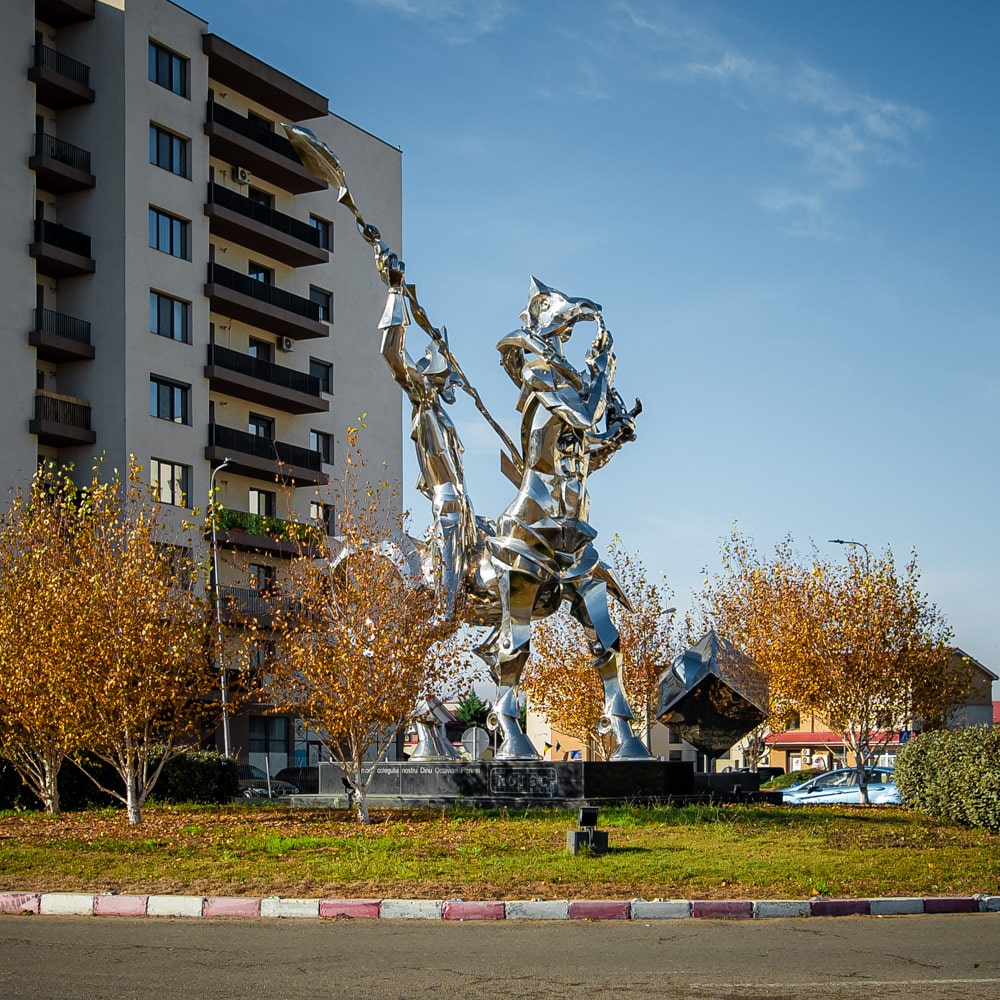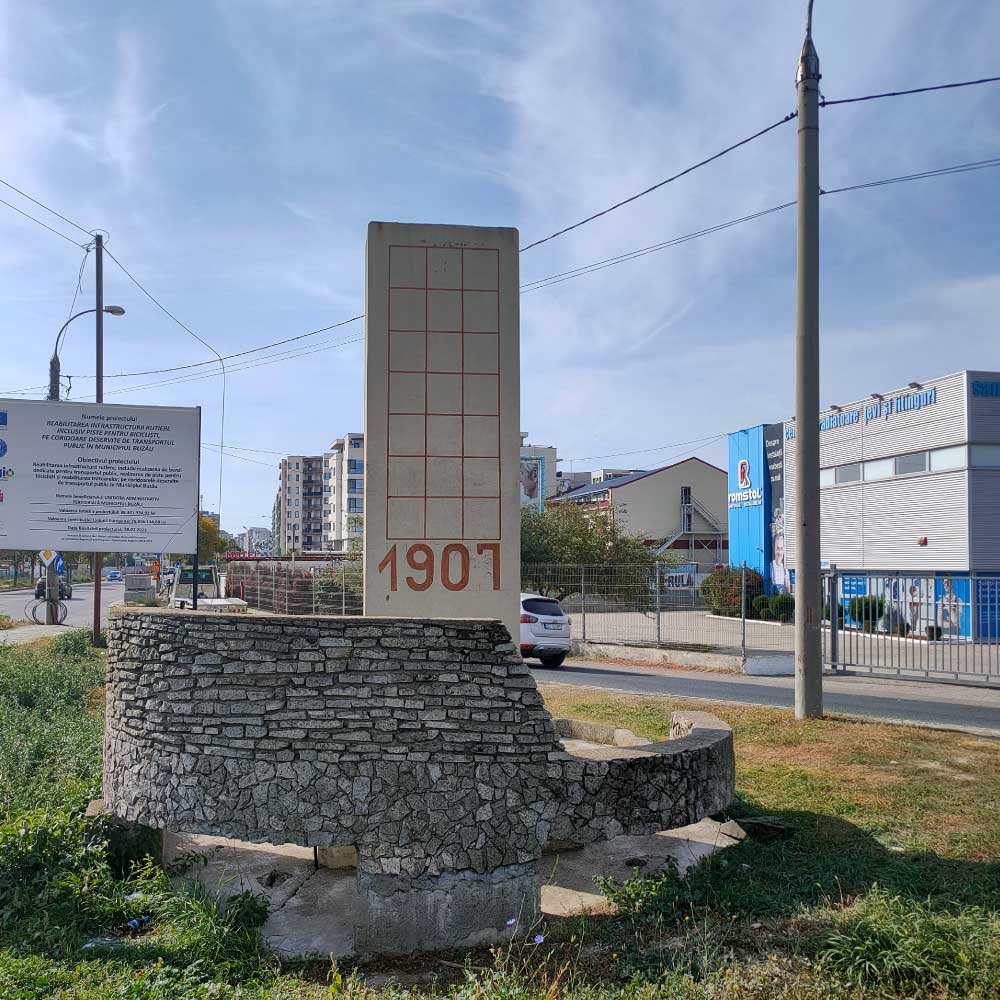
Omagiu
noiembrie 7, 2022
Monumentul comemorativ „1907”
noiembrie 7, 2022Română
OBELISCUL „BUZĂU 1600”
În anul 1976, când Buzăul a celebrat împlinirea a 1600 de ani de la prima sa menţiune documentară (în fapt 372 după Hristos, momentul martirizării Sfântului Sava Gotul în apele râului Buzău/Mousaios), în Parcul Crâng a fost ridicat un monument/obelisc care să marcheze această aniversare. Proiectat şi realizat din travertin de către sculptorul Gheorghe Coman, monumentul are 26,80 metri înălţime şi o fundaţie adâncă de 14 metri. Pe obelisc sunt aplicate patru basoreliefuri, având ca figuri marcante pe Burebista, Mihai Viteazul, Nicolae Bălcescu, cu aceiaşi tematică – continuitatea poporului român pe aceste meleaguri. Monumentul a fost inaugurat în anul 1976, în prezenţa preşedintelui de atunci al României, Nicolae Ceauşescu. Gheorghe Coman, născut în 1925 la Ploieşti, a absolvit Institutul de Arte Plastice din Bucureşti şi a fost preşedintele filialelor Uniunii Artiştilor Plastici din Ploieşti (din 1951) şi din Buzău (din 1968). A fost iniţiatorul Taberei de sculptură în aer liber de la Măgura (desfăşurată timp de 16 ediţii, între1970-1985). A fost premiat de mai multe ori, în 1976 primind Premiul Uniunii Artiştilor Plastici pentru basorelieful de pe "Fântâna lui Mihai Viteazul de la Măgura".
English
„BUZĂU 1600” OBELISC
In 1976, when Buzău celebrated 1600 years since its first documentary mention (actually 372 AD, the moment of the martyrdom of Saint Sava the Goth in the waters of the Buzău/Mousaios river), a monument/obelisk was erected in Crâng Park to mark this anniversary. Designed and made of travertine by sculptor Gheorghe Coman, the monument has a height of 26.80 meters and a deep foundation of 14 meters. Four bas-reliefs are placed on the obelisk, with Burebista, Mihai Viteazul, Nicolae Bălcescu as prominent figures, having the same theme – the continuity of the Romanian people on these lands. The monument was inaugurated in 1976, in the presence of the then president of Romania, Nicolae Ceaușescu. Gheorghe Coman, born in 1925 in Ploiești, graduated from the Institute of Fine Arts of Bucharest and he was president of the branches of the Union of Plastic Artists of Ploiești (since 1951) and Buzău (since 1968). He was the initiator of Măgura outdoor sculpture camp (held for 16 editions between 1970 and 1985). He was awarded several prizes, in 1976 he received the Union of Plastic Artists Award for the bas-relief on the Fountain of Mihai the Brave of Măgura.
Francais
OBÉLISQUE „BUZĂU 1600”
En 1976, lorsque Buzău a célébré le 1600e anniversaire de sa première mention documentaire (en fait 372 après J.C., l’époque du martyre de Saint Sava Gotul dans les eaux de la rivière Buzău/Mousaios), un monument/obélisque a été érigé dans le parc Crâng pour marquer cet anniversaire. Conçu et réalisé en travertin par le sculpteur Gheorghe Coman, le monument mesure 26,80 mètres de haut et possède des fondations profondes de 14 mètres. Quatre bas-reliefs sont placés sur l’obélisque, avec Burebista, Mihai Viteazul, Nicolae Bălcescu comme figures les plus importantes, avec le même thème – la continuité du peuple roumain sur ces terres. Le monument a été inauguré en 1976, en présence du président de la Roumanie de l’époque, Nicolae Ceaușescu. Gheorghe Coman, né en 1925 à Ploiești, est diplômé de l’Institut des beaux-arts de Bucarest et a été président des sections de l’Union des beaux-arts de Ploiești (depuis 1951) et de Buzău (depuis 1968). Il est l’initiateur du camp de sculpture en plein air de Măgura (tenu pendant 16 éditions entre 1970 et 1985). Il a obtenu plusieurs prix, en 1976, il a reçu le prix de l’Union des artistes pour le bas-relief de la Fontaine de Michel le Brave à Măgura.




